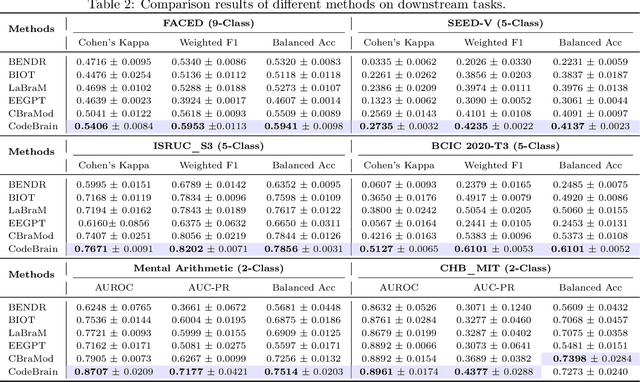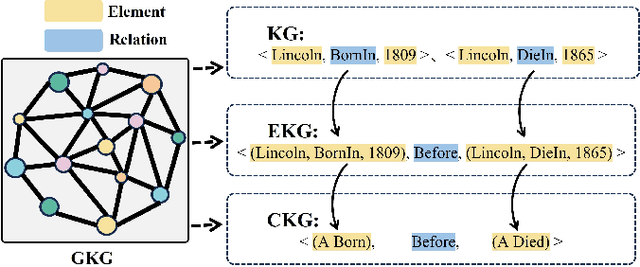Qika Lin
A Foundation Model for Chest X-ray Interpretation with Grounded Reasoning via Online Reinforcement Learning
Sep 04, 2025Abstract:Medical foundation models (FMs) have shown tremendous promise amid the rapid advancements in artificial intelligence (AI) technologies. However, current medical FMs typically generate answers in a black-box manner, lacking transparent reasoning processes and locally grounded interpretability, which hinders their practical clinical deployments. To this end, we introduce DeepMedix-R1, a holistic medical FM for chest X-ray (CXR) interpretation. It leverages a sequential training pipeline: initially fine-tuned on curated CXR instruction data to equip with fundamental CXR interpretation capabilities, then exposed to high-quality synthetic reasoning samples to enable cold-start reasoning, and finally refined via online reinforcement learning to enhance both grounded reasoning quality and generation performance. Thus, the model produces both an answer and reasoning steps tied to the image's local regions for each query. Quantitative evaluation demonstrates substantial improvements in report generation (e.g., 14.54% and 31.32% over LLaVA-Rad and MedGemma) and visual question answering (e.g., 57.75% and 23.06% over MedGemma and CheXagent) tasks. To facilitate robust assessment, we propose Report Arena, a benchmarking framework using advanced language models to evaluate answer quality, further highlighting the superiority of DeepMedix-R1. Expert review of generated reasoning steps reveals greater interpretability and clinical plausibility compared to the established Qwen2.5-VL-7B model (0.7416 vs. 0.2584 overall preference). Collectively, our work advances medical FM development toward holistic, transparent, and clinically actionable modeling for CXR interpretation.
Graph-R1: Towards Agentic GraphRAG Framework via End-to-end Reinforcement Learning
Jul 29, 2025Abstract:Retrieval-Augmented Generation (RAG) mitigates hallucination in LLMs by incorporating external knowledge, but relies on chunk-based retrieval that lacks structural semantics. GraphRAG methods improve RAG by modeling knowledge as entity-relation graphs, but still face challenges in high construction cost, fixed one-time retrieval, and reliance on long-context reasoning and prompt design. To address these challenges, we propose Graph-R1, an agentic GraphRAG framework via end-to-end reinforcement learning (RL). It introduces lightweight knowledge hypergraph construction, models retrieval as a multi-turn agent-environment interaction, and optimizes the agent process via an end-to-end reward mechanism. Experiments on standard RAG datasets show that Graph-R1 outperforms traditional GraphRAG and RL-enhanced RAG methods in reasoning accuracy, retrieval efficiency, and generation quality.
Synergistic Prompting for Robust Visual Recognition with Missing Modalities
Jul 10, 2025Abstract:Large-scale multi-modal models have demonstrated remarkable performance across various visual recognition tasks by leveraging extensive paired multi-modal training data. However, in real-world applications, the presence of missing or incomplete modality inputs often leads to significant performance degradation. Recent research has focused on prompt-based strategies to tackle this issue; however, existing methods are hindered by two major limitations: (1) static prompts lack the flexibility to adapt to varying missing-data conditions, and (2) basic prompt-tuning methods struggle to ensure reliable performance when critical modalities are missing.To address these challenges, we propose a novel Synergistic Prompting (SyP) framework for robust visual recognition with missing modalities. The proposed SyP introduces two key innovations: (I) a Dynamic Adapter, which computes adaptive scaling factors to dynamically generate prompts, replacing static parameters for flexible multi-modal adaptation, and (II) a Synergistic Prompting Strategy, which combines static and dynamic prompts to balance information across modalities, ensuring robust reasoning even when key modalities are missing. The proposed SyP achieves significant performance improvements over existing approaches across three widely-used visual recognition datasets, demonstrating robustness under diverse missing rates and conditions. Extensive experiments and ablation studies validate its effectiveness in handling missing modalities, highlighting its superior adaptability and reliability.
CodeBrain: Bridging Decoupled Tokenizer and Multi-Scale Architecture for EEG Foundation Model
Jun 10, 2025



Abstract:Electroencephalography (EEG) provides real-time insights into brain activity and is widely used in neuroscience. However, variations in channel configurations, sequence lengths, and task objectives limit the transferability of traditional task-specific models. Although recent EEG foundation models (EFMs) aim to learn generalizable representations, they struggle with limited heterogeneous representation capacity and inefficiency in capturing multi-scale brain dependencies. To address these challenges, we propose CodeBrain, an efficient EFM structurally aligned with brain organization, trained in two stages. (1) We introduce a TFDual-Tokenizer that independently tokenizes heterogeneous temporal and frequency components, enabling a quadratic expansion of the discrete representation space. This also offers a degree of interpretability through cross-domain token analysis. (2) We propose the EEGSSM, which combines a structured global convolution architecture and a sliding window attention mechanism to jointly model sparse long-range and local dependencies. Unlike fully connected Transformer models, EEGSSM better reflects the brain's small-world topology and efficiently captures EEG's inherent multi-scale structure. EEGSSM is trained with a masked self-supervised learning objective to predict token indices obtained in TFDual-Tokenizer. Comprehensive experiments on 10 public EEG datasets demonstrate the generalizability of CodeBrain with linear probing. By offering biologically informed and interpretable EEG modeling, CodeBrain lays the foundation for future neuroscience research. Both code and pretraining weights will be released in the future version.
Segment Any RGB-Thermal Model with Language-aided Distillation
May 04, 2025Abstract:The recent Segment Anything Model (SAM) demonstrates strong instance segmentation performance across various downstream tasks. However, SAM is trained solely on RGB data, limiting its direct applicability to RGB-thermal (RGB-T) semantic segmentation. Given that RGB-T provides a robust solution for scene understanding in adverse weather and lighting conditions, such as low light and overexposure, we propose a novel framework, SARTM, which customizes the powerful SAM for RGB-T semantic segmentation. Our key idea is to unleash the potential of SAM while introduce semantic understanding modules for RGB-T data pairs. Specifically, our framework first involves fine tuning the original SAM by adding extra LoRA layers, aiming at preserving SAM's strong generalization and segmentation capabilities for downstream tasks. Secondly, we introduce language information as guidance for training our SARTM. To address cross-modal inconsistencies, we introduce a Cross-Modal Knowledge Distillation(CMKD) module that effectively achieves modality adaptation while maintaining its generalization capabilities. This semantic module enables the minimization of modality gaps and alleviates semantic ambiguity, facilitating the combination of any modality under any visual conditions. Furthermore, we enhance the segmentation performance by adjusting the segmentation head of SAM and incorporating an auxiliary semantic segmentation head, which integrates multi-scale features for effective fusion. Extensive experiments are conducted across three multi-modal RGBT semantic segmentation benchmarks: MFNET, PST900, and FMB. Both quantitative and qualitative results consistently demonstrate that the proposed SARTM significantly outperforms state-of-the-art approaches across a variety of conditions.
Exploring Cognitive and Aesthetic Causality for Multimodal Aspect-Based Sentiment Analysis
Apr 22, 2025



Abstract:Multimodal aspect-based sentiment classification (MASC) is an emerging task due to an increase in user-generated multimodal content on social platforms, aimed at predicting sentiment polarity toward specific aspect targets (i.e., entities or attributes explicitly mentioned in text-image pairs). Despite extensive efforts and significant achievements in existing MASC, substantial gaps remain in understanding fine-grained visual content and the cognitive rationales derived from semantic content and impressions (cognitive interpretations of emotions evoked by image content). In this study, we present Chimera: a cognitive and aesthetic sentiment causality understanding framework to derive fine-grained holistic features of aspects and infer the fundamental drivers of sentiment expression from both semantic perspectives and affective-cognitive resonance (the synergistic effect between emotional responses and cognitive interpretations). Specifically, this framework first incorporates visual patch features for patch-word alignment. Meanwhile, it extracts coarse-grained visual features (e.g., overall image representation) and fine-grained visual regions (e.g., aspect-related regions) and translates them into corresponding textual descriptions (e.g., facial, aesthetic). Finally, we leverage the sentimental causes and impressions generated by a large language model (LLM) to enhance the model's awareness of sentimental cues evoked by semantic content and affective-cognitive resonance. Experimental results on standard MASC datasets demonstrate the effectiveness of the proposed model, which also exhibits greater flexibility to MASC compared to LLMs such as GPT-4o. We have publicly released the complete implementation and dataset at https://github.com/Xillv/Chimera
HyperGraphRAG: Retrieval-Augmented Generation with Hypergraph-Structured Knowledge Representation
Mar 27, 2025Abstract:While standard Retrieval-Augmented Generation (RAG) based on chunks, GraphRAG structures knowledge as graphs to leverage the relations among entities. However, previous GraphRAG methods are limited by binary relations: one edge in the graph only connects two entities, which cannot well model the n-ary relations among more than two entities that widely exist in reality. To address this limitation, we propose HyperGraphRAG, a novel hypergraph-based RAG method that represents n-ary relational facts via hyperedges, modeling the complicated n-ary relations in the real world. To retrieve and generate over hypergraphs, we introduce a complete pipeline with a hypergraph construction method, a hypergraph retrieval strategy, and a hypergraph-guided generation mechanism. Experiments across medicine, agriculture, computer science, and law demonstrate that HyperGraphRAG outperforms standard RAG and GraphRAG in accuracy and generation quality.
$φ$-Decoding: Adaptive Foresight Sampling for Balanced Inference-Time Exploration and Exploitation
Mar 17, 2025Abstract:Inference-time optimization scales computation to derive deliberate reasoning steps for effective performance. While previous search-based strategies address the short-sightedness of auto-regressive generation, the vast search space leads to excessive exploration and insufficient exploitation. To strike an efficient balance to derive the optimal step, we frame the decoding strategy as foresight sampling, leveraging simulated future steps to obtain globally optimal step estimation. Built on it, we propose a novel decoding strategy, named $\phi$-Decoding. To provide a precise and expressive estimation of step value, $\phi$-Decoding approximates two distributions via foresight and clustering. Sampling from the joint distribution, the optimal steps can be selected for exploitation. To support adaptive computation allocation, we propose in-width and in-depth pruning strategies, featuring a light-weight solution to achieve inference efficiency. Extensive experiments across seven benchmarks show $\phi$-Decoding outperforms strong baselines in both performance and efficiency. Additional analysis demonstrates its generalization across various LLMs and scalability across a wide range of computing budgets. The code will be released at https://github.com/xufangzhi/phi-Decoding, and the open-source PyPI package is coming soon.
GKG-LLM: A Unified Framework for Generalized Knowledge Graph Construction
Mar 17, 2025



Abstract:The construction of Generalized Knowledge Graph (GKG), including knowledge graph, event knowledge graph and commonsense knowledge graph, is fundamental for various natural language processing tasks. Current studies typically construct these types of graph separately, overlooking holistic insights and potential unification that could be beneficial in computing resources and usage perspectives. However, a key challenge in developing a unified framework for GKG is obstacles arising from task-specific differences. In this study, we propose a unified framework for constructing generalized knowledge graphs to address this challenge. First, we collect data from 15 sub-tasks in 29 datasets across the three types of graphs, categorizing them into in-sample, counter-task, and out-of-distribution (OOD) data. Then, we propose a three-stage curriculum learning fine-tuning framework, by iteratively injecting knowledge from the three types of graphs into the Large Language Models. Extensive experiments show that our proposed model improves the construction of all three graph types across in-domain, OOD and counter-task data.
KBQA-o1: Agentic Knowledge Base Question Answering with Monte Carlo Tree Search
Jan 31, 2025



Abstract:Knowledge Base Question Answering (KBQA) aims to answer natural language questions with a large-scale structured knowledge base (KB). Despite advancements with large language models (LLMs), KBQA still faces challenges in weak KB awareness, imbalance between effectiveness and efficiency, and high reliance on annotated data. To address these challenges, we propose KBQA-o1, a novel agentic KBQA method with Monte Carlo Tree Search (MCTS). It introduces a ReAct-based agent process for stepwise logical form generation with KB environment exploration. Moreover, it employs MCTS, a heuristic search method driven by policy and reward models, to balance agentic exploration's performance and search space. With heuristic exploration, KBQA-o1 generates high-quality annotations for further improvement by incremental fine-tuning. Experimental results show that KBQA-o1 outperforms previous low-resource KBQA methods with limited annotated data, boosting Llama-3.1-8B model's GrailQA F1 performance to 78.5% compared to 48.5% of the previous sota method with GPT-3.5-turbo.
 Add to Chrome
Add to Chrome Add to Firefox
Add to Firefox Add to Edge
Add to Edge